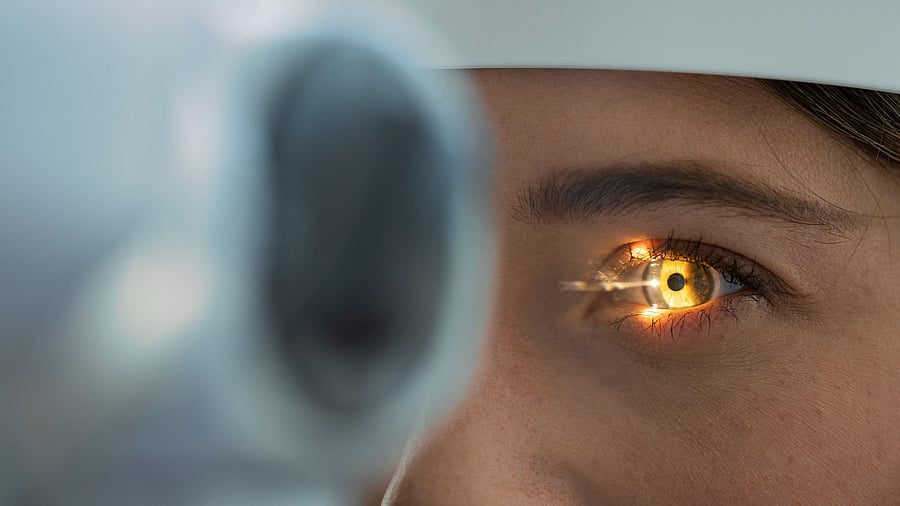
A patient at the ophthalmologists'
Credit: iStock Photo
The World Glaucoma Week is observed from March 9 to 15 to raise awareness about the eye disease. India has been a participating nation in this initiative since 2006. This year’s theme, ‘Uniting for a Glaucoma-Free World’, highlights the need for early detection.
Glaucoma, a group of diseases causing increased eye pressure, can lead to irreversible blindness if left untreated. Many patients remain unaware due to a lack of symptoms in the early stages, making timely diagnosis crucial for preserving vision. Understanding the risk factors and scheduling regular eye exams can help prevent vision loss.
As per the National Blindness and Visual Impairment Survey of India, 2015-2019, around 5.5 per cent of blindness in India is attributed to this disease, and by 2040, India and China are likely to share the maximum burden of glaucoma in Asia. Glaucoma ranks as the third leading cause of blindness in India, highlighting the importance of widespread awareness.
Glaucoma poses a greater public health challenge in India’s rural areas than in urban regions. This is mainly because of the limited access to eye care services, low awareness about the illness, and financial constraints, making early detection and treatment much more difficult.
Glaucoma awareness in developing nations depends on healthcare infrastructure, government initiatives, and public education. Middle-income countries like China and Brazil have better healthcare access and awareness programmes, leading to higher awareness than in India. Bangladesh, Nigeria, and Pakistan have glaucoma awareness levels similar to India. However, low-income nations, especially in Sub-Saharan Africa and remote Southeast Asian regions, struggle with poor eye care access, low awareness, and financial barriers.
India has made notable strides in improving glaucoma awareness, but rural areas continue to face difficulties, much like many other developing countries.
Eye care professionals in India face multiple challenges in addressing glaucoma. Patients generally lack awareness about the severity of the disease. In many cases, even after being diagnosed, patients often do not take the condition seriously and fail to adhere to prescribed treatment. They tend to neglect the regular use of eye drops, ultimately leading to irreversible blindness.
Additionally, glaucoma has a hereditary component, yet there is a lack of awareness among family members who may also be at risk. Therefore, screening family members and informing both patients and their relatives about the risks is crucial.
During rural eye health camps, ophthalmologists encounter another challenge where patients neglect prescribed treatments and fail to follow up on regular check-ups. Furthermore, in advanced cases, when surgery is recommended, many refuse the procedure, increasing their risk of optic atrophy, and irreversible blindness.
The economic burden of treating glaucoma is high. Even though the Government of India’s Pradhan Mantri Bhartiya Janaushadhi Pariyojana (PMBJP) scheme helps provide quality generic medicines and surgical equipment at affordable prices, there are concerns with quality, ophthalmologists’ trust, and precision about generic medicines for eye care. By enhancing regulation, education, and research, India can ensure that generic medicines contribute effectively to expanding eye care accessibility while maintaining safety and efficacy. Therefore, transitioning gradually to generic medicines holds significant potential for reducing healthcare costs in eye care.
A promising area for tackling glaucoma is the role of Artificial Intelligence. AI can be used to interpret images of an individual’s optic nerve which can help in detecting this disease on a large scale during its early phases. It’s also expected that in the future, monitors could be developed through AI, which could guide ophthalmologists in the follow-up of patients, and ensure that drugs are administered through delivery devices. Government agencies can also use AI to spread awareness about this disease through social media platforms.
AI algorithms and teleophthalmology are cost-effective techniques to diagnose glaucoma in India where there is a growing aging population which often lack social security benefits. Studies also show that an algorithmic approach to ocular examinations may reduce the problem of over- or under-diagnosis of glaucoma.
Thus, AI can act as a complement than a substitute to improve efficiency of healthcare workers. However, the use of AI in detecting and treating glaucoma in India remains a distant goal. Providing such services alone may not be sufficient, but their implementation in rural areas should be both feasible and potentially impactful.
(Megha Jacob is assistant professor, Department of Economics, Jesus and Mary College, University of Delhi. Sukanya Das is professor, Department of Policy and Management Studies and Dean (Research & Partnerships), TERI School of Advanced Studies, New Delhi. Neha Jacob is junior resident, Department of Ophthalmology, Rajarajeshwari Medical College and Hospital, Bengaluru, Karnataka.)
Disclaimer: The views expressed above are the author's own. They do not necessarily reflect the views of DH.